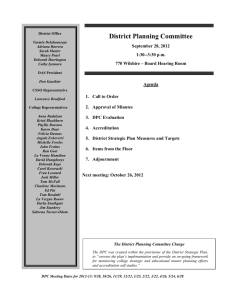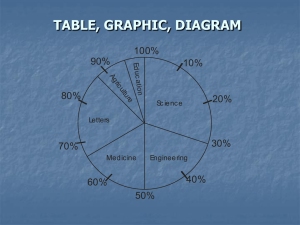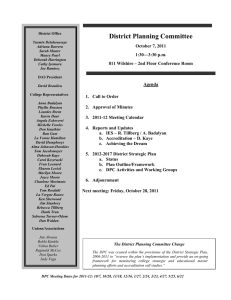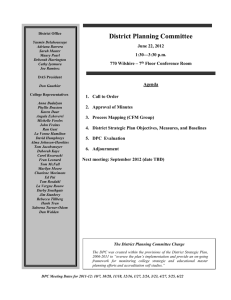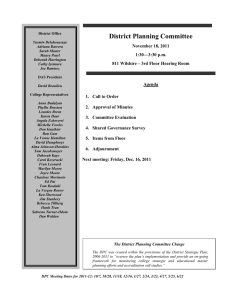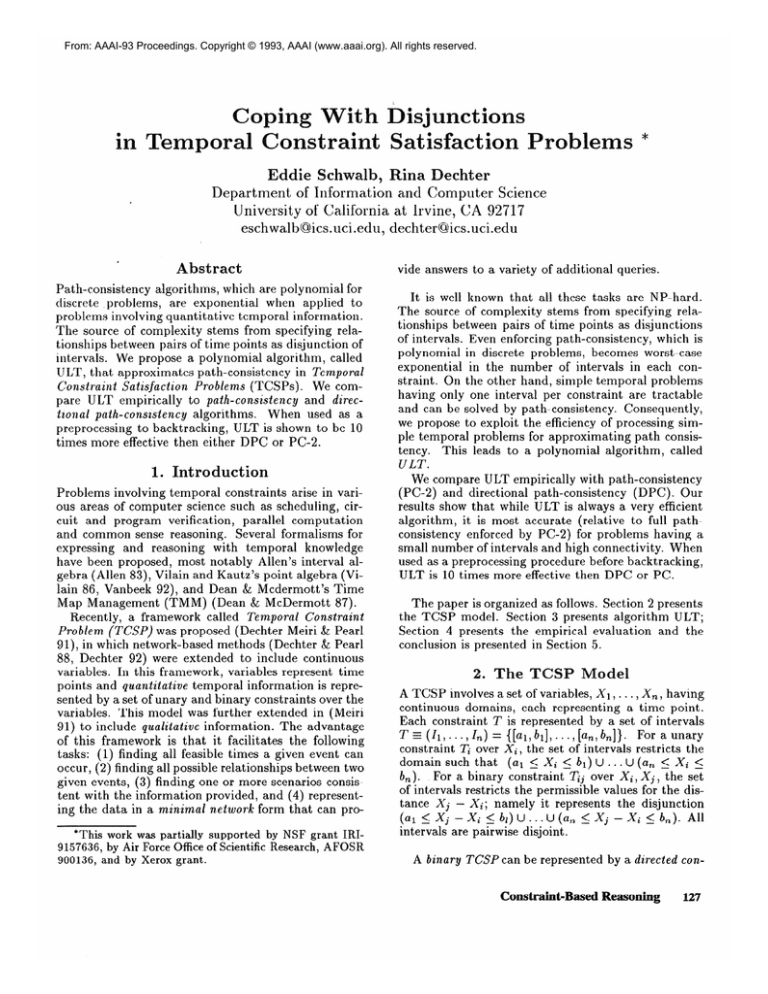
From: AAAI-93 Proceedings. Copyright © 1993, AAAI (www.aaai.org). All rights reserved.
in Temporal
it
Constraint
Eddie Schwalb, Rina Dechter
Department of Information and Computer Science
University of California at Irvine, CA 92717
eschwalbQics.uci.edu,
dechter@ics.uci.edu
Abstract
Path-consistency
algorithms,
which are polynomial for
discrete problems,
are exponential
when applied to
problems involving quantitative
temporal information.
The source of complexity
stems from specifying relationships between pairs of time points as disjunction
of
intervals.
We propose a polynomial
algorithm,
called
ULT, that approximates
path-consistency
in Temporal
We comConstraint Satisfaction
Problems (TCSPs).
pare ULT empirically
to path-consistency
and directional path-consistency
algorithms.
When used as a
preprocessing
to backtracking,
ULT is shown to be 10
times more effective then either DPC or PC-2.
I. Introduction
Problems involving temporal constraints
arise in various areas of computer science such as scheduling,
circuit and program verification,
parallel computation
and common sense reasoning.
Several formalisms for
expressing
and reasoning
with temporal
knowledge
have been proposed, most notably Allen’s interval algebra (Allen 83), Vilain and Kautz’s point algebra (Vilain 86, Vanbeek 92)) and Dean & Mcdermott’s
Time
Map Management
(TMM) (Dean & McDermott
87).
Recently, a framework
called Temporal Constraint
Pro b/em (TCSP) was proposed (Dechter Meiri & Pearl
91)) in which network-based
methods (Dechter & Pearl
88, Dechter 92) were extended to include continuous
variables.
In this framework, variables represent time
points and quantitative temporal information
is represented by a set of unary and binary constraints over the
variables.
This model was further extended in (Meiri
The advantage
91) to include qualitative information.
of this framework is that it facilitates
the following
tasks: (1) finding all feasible times a given event can
occur, (2) finding all possible relationships
between two
given events, (3) finding one or more scenarios consistent with the information
provided, and (4) representing the data in a minimal network form that can pro*This work was partially supported
by NSF grant IRI9157636,
by Air Force Office of Scientific Research, AFOSR
900136,
and by Xerox grant.
vide answers
to a variety
of additional
queries.
It is well known that all these tasks are NP-hard.
The source of complexity
stems from specifying relationships between pairs of time points as disjunctions
of intervals. Even enforcing path-consistency,
which is
polynomial
in discrete problems, becomes worst-case
exponential
in the number of intervals in each constraint. On the other hand, simple temporal problems
having only one interval per constraint
are tractable
and can be solved by path-consistency.
Consequently,
we propose to exploit the efficiency of processing simple temporal problems for approximating
path consistency.
This leads to a polynomial
algorithm,
called
ULT.
We compare ULT empirically with path-consistency
(PC-2) and directional
path-consistency
(DPC). Our
results show that while ULT is always a very efficient
algorithm,
it is most accurate (relative to full pathconsistency
enforced by PC-2) for problems having a
small number of intervals and high connectivity.
When
used as a preprocessing
procedure before backtracking,
ULT is 10 times more effective then DPC or PC.
The paper is organized as follows. Section 2 presents
the TCSP model. Section 3 presents algorithm
ULT;
Section 4 presents the empirical evaluation
and the
conclusion is presented in Section 5.
2. The T’CS
ode1
A TCSP involves a set of variables, X1, . . . , X,, having
continuous
domains, each representing
a time point.
Each constraint
T is represented
by a set of intervals
Tr&...
For a unary
, In> = {[al, h], . . . , [a,, bn]}.
constraint
Ti over Xi, the set of intervals restricts the
domain such that (al 5 Xi < bl) U . . . U (a, 5 Xi 5
b,).
For a binary constraint
Taj over Xi, Xj , the set
of intervals restricts the permissible values for the distance
Xj - Xi; namely
it represents
the disjunction
- Xi 5 bl) u . . . u (a, 5 Xj - Xi 5 b,). All
(a1
F xj
intervals are pairwise disjoint.
A binary TCSP can be represented
Constraint-Based
by a directed conReasoning
127
straint graph, where nodes represent variables and an
edge z’---+j indicates that a constraint
Tij is specified.
Every edge is labeled by the interval set (Figure 1).
A special time point X0 is introduced
to represent the
“beginning
of the world”. Because all times a.re relative to X0, thus we may treat each unary constraint
Ti as a binary constraint Toi (having the same interval
representation).
For simplicity, we choose X0 = 0.
To1
To3
7’12
T13
=
=
=
=
=
m,21,
13,411
{[2, 131, (14,171, [18,20]}
{[2,4],
[6,71)
{[0,4],
[6,91, 1139151)
To1 E (1 5 Xl 52)
” (3 5 Xl i 4)
To’03
z (2 5 X3 5 13) ” (14 < X3 5 17) ” (18 5 X3 5 2’3)
(2 5 X2 (0 5 X3 (0 I
X1 5 4)
X1 < 4)
X3 -X2
U (6 5 X2 -X1
U (6 5 X3 - Xl
5 7)
5 9)
u
(13 5 x3
-
x1
< 15)
55)
Figure 1: A graphical representation of a TCSP
where X0 = 0, XI = 1.5, X2 = 4.5, X3 = 8 is a solution.
A tuple
X = (xl,...,
x~) is called a solution
if
the assignment
X1 = x1, . . . , Xn = zn satisfies all
the constraints.
The network is consistent iff at least
one solution exists.
A value v is a feasible value of
Xi if there exists a solution in which Xi = v. The
minimal domain of a variable is the set of all feasible
values of that variable.
The minimal constraint is the
tightest constraint
that describes the same set of solutions. The minimal network is such that its domains
and cbnstraints
are minimal.
Definition
1:
Let T = {II,. . .,Il}
and
S =
{JI,... , jm} be two sets of intervals which can correspond to either unary or binary constraints.
1. The intersection of T and S, denoted by T
admits only values that tire allowed by both
2. The composition of T and S, denoted by T
mits only values T for which there exists t
s E S such that Y = t + s.
-2
-1
0
1
2
3
4
5
6
7
8
@ S,
of them.
@IS, adE T and
9
T
s
T@S
T
S
T @ S
T @I S
Figure
2:
=
=
=
=
([--1.25,0.25],[2.75,4.25]}
{[-0.25J.251, [3.77,4.25]}
{[-0.25,0.25], [3.75,4.25]}
{[-1.50,1.50], [2.50,5.50],[6.50,8.50]}
A pictorial
example
of the @ and @I operations.
The @Ioperation may result in intervals that are not
pairwise disjoint. Therefore, additional processing may
be required to compute the disjoint interval set.
Definition
ables
128
2:
The path-induced constraint
X.2’X.3 is Rpa”
= @vk:(Tik 8 Tkj).
ij
Schwalb
Tij is path-consistent
iff Tij c Ry’fth and pclfh-
iff Tij _> Rflyth. A network is path-consisfc~,t
ifF all its constraints
are path-consistent.
redundant
A general
TCSP can be converted into a.n equivalent
network by applying the relaxation opTij cf, Ti,+ 0 Tkj, using algorit8hm PC-2
(Figure 3). Some problems may benefit from a weaker
version, called DPC, which can be enforced more efficiently.
path-consistent
eration Tij c
Algorithm PC-2
1. Q t- ((4 k-,.i)l(i < j)and(k # G)l
2.
while Q # {} do
T23 {[“>51)
T12 f
T13 =
T23 E
straint
on variA con-
3.
4.
5.
6.
7.
8.
select
and delete a path (it k, j) from Q
if Tij # Tik @ Tkl then
end
9.
T,, t- Z3 @ (%c @ T/cl)
if Ttj = {}
then exit (inconsistency)
$t
Q u RELATED-PATHS((i,k,j))
end-while
Algorithm DPC
1. for k t n downto
2.
3.
4.
5.
6.
7.
8.
9.
for
1 by -1 do
Vi, j < k such that (i, I;), (k, j) E E do
if Til # % @JTkl then
E t Eu (i,j)
X3
+- T2j CB (r/c C3 Tk3)
then exit (inconsistency)
if Tzj = (}
end-if
end-for
end-for
Figure 3: Algorithms
PC-2 and DPC (Dechter
Meiri
& Pearl 91).
3. Upper-Lower
Tightening
(ULT)
The relaxation operation Tij + Tij $Tih @Tkj increases
the number of intervals and may result in exponential
blow-up. As a result, the complexity of PC-2 and DPC
is exponential
in the number of intervals, but can be
bounded by O(n3 R3) and O(n3R2), respectively, where
n is the number of variables and R is the range of the
constraints.
When running PC-2 on random instances,
we encountered
problems for which path-consistency
required 11 minutes on toy-sized problems with 10 variables, range of [O,SOO], and with 50 input intervals in
Evidently,
PC-2 is computationally
each constraint.
expensive (also observed by (Poesio 91)).
A special class of TCSPs that allow efficient processing is the Simple Temporal Problem (STP) (Dechter
Meiri & Pearl 91). In this class, a constraint
has a single interval. An STP can be associated with a directed
edge-weighted graph, Gd, called a distance graph, having the same vertices as the constraint
graph 6; each
edge i --f j is labeled by a weight Waj representing
the constraint
Xj - Xi 5 wij (Figure 4). An STP
is consistent iff the corresponding
d-graph Gd has no
negative cycles and the minimal network of the STP
N
PJ31
114.173
[18.201
N;l)
i2.41
r2.71
WOI
W.71
k71
~41
v.41
b5.71
D5.71
Figure 5: A sample run of ULT.
We start with N (Figure 1) and compute NII ), IV;;,, N(y). Thereafter, we perform a
second iteration in which we compute Ni2,, N;;), N;I; and finally, in the third iteration, there is no change. The first
iteration removes two intervals, while the second iteration removes one.
corresponds to the ~ninimal distances of Gd. For a processing example, see figure 4. Alternatively,
the minimal network of an STP can be computed by PC-2 in
O(n3) steps.
F'loyd
- Warshall
Minimal Distance
Algorithm
1.
2.
3.
4.
5.
6.
7.
input:
repeat
N c
until
Vij (L:; = Lt3) and (Vi; = U;j)
or 3ij (‘7;‘: < L{‘,/)
if Vij (V,:’ > L::)
output: “Inconsistent.”
otherwise
6: The
Figure
an STP. The minimal rletwork is in
Figure 5, network N(i)
.
Motivated by these results, we propose an efficient
The
algorithm
that approximates
path-consistency.
idea is to use the extreme points of all intervals associated with a single constraint
as one big interval, yielding an STP, and then to perform path-consistency
on
that STP. This process will not increasing the number
of intervals.
Definition 3 :
Let xj = [II, . . . , I,,,] be the constraint over variables Xi, Xj and let Lij, Uij be the
lowest and highest value of Tij, respectively.
We define N’, N”, N”’ as follows (see Figure 5):
N”’
compute Iv’, N”, N”‘.
12201
Figure 4: Processing
Tightening CULT)
IJpper-Lower
N
N”’ c N
output:
ULT
N”’
algorithm.
o N’ is an STP derived from N by relaxing
straints to Tij = [Lij, Uij].
e Iv” is the minimal network
o N”’ is derived from N”
‘I/; = q/ @ Tij .
of Iv’.
and N
its con-
by intersecting
Algorithm
ULT is presented
in Figure 6. We can
show that LJLT computes a network equivalent
to its
input network.
Lemma
output.
1: Let N be th,e input to ULT and R be its
The networks N and R are equivalent.
Regarding
that
Lemma
lust)
2:
removes
the effectiveness
Every
at
least
iteration
one
of LJLT, we can show
of ULT (excluding
the
interval.
Constraint-Based
Reasoning
I.29
Effwiency of ULT, DPC, PC-2, PC- l(20 reps)
on 10 variables, tightness .95, Pc=O.14
This can be used to show that
Theorem
1: Algor-%thm ULT terminates in 0( n3ek+
e’k”) steps where n is the number of variables, e is
the number of edges, and k is the maximal
number of
il~tervnls in each constraint.
ULT
DPC
PC-2
PC-1
100
In contrast to PC-2, ULT is guaranteed
to converge in
O(ek) iterations
even if the interval boundaries
are not
rational numbers.
For a sample execution see Figure
5.
Algorithm
path-
ULT can also be used to identify
.....................................................................
redundancies.
I
.OOl
0
Definition
after applying
A constraint Tij is redundant-prone
ULT, T[j’ is redundant
in N”‘.
Lemma
Tii’ is path-redundant
4:
3:
in N”’
if
20
iff,
T/j
5
Tij
is
.
I
1
40
,
.
60
,
80
Number of Intervals
Approximation
on 10 variables,
Quality relative to PC
tightness .95, Pc=.14
Tij and T/j = @i/k (2-g c3 7-g.
Corollary
1 :
redundant-prone
A single
interval
constraint
# T/i = @vh(TiL 8 TL>).
Consequently,
after applying ULT to a TCSP, we can
test the condition in Corollary 1 and eliminate some redundant constraints.
A brute-force
algorithm for solving a TCSP decomposes it into separate STPs by selecting a single interval from each constraint
(Dechter Meiri & Pearl 91).
Each STP is then solved separately
and the solutions
are combined.
Alternatively,
a naive backtracking
algorithm will successively
assign an interval to a constraint,
as long as the resulting
STP is consistent.’
Once inconsistency
is detected,
the algorithm
backtracks. Algorithm
ULT can be used as a preprocessing stage to reduce the number of intervals in each
constraint
and to identify some path-redundant
constraints.
Since every iteration of ULT removes at least
one interval, the search space is pruned. More importantly, if ULT causes redundant
constraints
to be removed, the search space may be pruned exponentially
in the number of constraints
removed.
Note however
that the number of constraints
in the initial network
is e while following the application
of ULT, DPC or
PC-2, the constraint
graph becomes complete thus the
number of constraints
is O(n’).
4. Empirical
Evaluation
We conducted two sets of experiments.
One comparing
the efficiency and accuracy of ULT and DPC relative
to PC-2, and the other comparing
their effectiveness
as a preprocessing
to backtracking.
Our experiments
were conducted on randomly generated sets of instances.
Our random problem generator
uses five parameters:
(1) n, the number of variables,
(2) k, the number of intervals in each constraint,
(3)
‘We
130
call this p recess
Schwalb
“labeling
the TCSP”.
-I-
L4
0
20
40
60
80
Number of Intervals
Figure 8: The execution
time and quality of the approximation obtained by DPC and ULT to PC. Each point
.95
represents
20 runs on networks with 10 variables,
tightness, connectivity
PC = .14 and range [0,600].
R = [Inf,Sup], the range of the constraints,
(4) TI,
the tightness of the constraints,
namely, the fraction
of values allowed relative to the interval [Inf,Sup], and
(5) PC, the probability
that a constraint
Tij exists.
Intuitively,
problems with dense graphs and loose constraints with many intervals should be more difficult.
To evaluate
the quality
of the approximation
achieved by ULT and DPC relative
to PC-2, we
counted the number of cases in which ULT and DPC
detected inconsistency
given that PC-2 detected one.
From Figure 8, we conclude that when the number of
intervals is small, DPC is faster than ULT but produces
weaker approximations.
When the number of intervals
is large, DPC is much slower but is more accurate. In
addition, we observe that when the number of intervals
is very large, DPC computes a very good approximation to PC-2, and runs about 10 times faster.
In Figure 9 we report the relative quality of ULT
and DPC for a small (3) and for a large (20) number
of intervals, as a function of connectivity.
As the connectivity increases, the approximation
quality of both
Approximation Qndity relative to PC
on 10 variables, 3 intervals, tightness .OS
0.08
0.10
0.12
0.14
Connectivity
0.16
0.18
parameter
Iterntiw
0.20
count of ULT,
20
Pc
PC-2, PC- 1
-
ULT
h
PC-2
-
PC-I
40
30
Number of intervals
Approximation Quality relative to PC
on 10 variables, 20 intervals, tightness .!I5
Iteration count for ULT, PC-2, PC-1
ULT
A
La
DPC
ULT
18
PC-2
PC- 1
E
0.06
0.08
0.10
0.12
Connectivity
0.14
0.16
parameter
0.18
0.08
0.20
PC
Figure
9: Quality of the approximation
vs connectivity
on problems with 10 variables, tightness .95 and range
[0,600].
We measured on problems of 3 intervals (top)
where each point represents
1000 runs, and on 20 intervals (bottom)
where each point represents
100 runs,
1JLT and DPC increases.
Note again that ULT is more
accurate
for a small number of intervals while DPC
dominates
for large nulnber of intervals.
We measured the number of iterations performed by
ULT, PC-2, and PC-l’ (Figure 10). We observe that
for our benchmarks,
lJLT performed
1 iteration
(excluding the termination
iteration) in most of the cases,
while PC-1 and PC-2 performed more (DPC performs
only one iteration).
In the second set of experiments
we tested the power
of ZIJLT, DPC and PC-2 as preprocessing
to backtracking. Without preprocessing,
the problems could not be
solved using the naive ba.cktracking.
Our preliminary
tests ra.n on 20 problem instances with 10 variables and
3 intervals and none terminated
before 1000000 STP
checks. We therefore cont,inuecl with testing backtracking following preprocessing
by ULT, DPC and PC-2.
2A brute force
Meiri & Pearl).
path-consistency
0.10
0.12
Connectivity
algorithm
0.14
0.16
Parameter
0.18
0.20
PC
Figure
10: The number of iterations
ULT, PC-2 and
PC-l performed (excluding the termination
iteration)
on
problems with 10 variables, 20 intervals, PC = .14, and
tightness .95. Each point represents 20 runs.
Testing the consistency
of a labeling requires solving
the corresponding
STP. An inconsistent
STP represents a dead-end.
Therefore, we counted the number
of inconsistent
STPs tested before a single consistent
one was found and the overall time required (including
preprocessing).
The results are presented in Figure 11
on a Iogarithnlic
scale.
We observe that ULT was
able to remove intervals effectively and appears to be
the most effective as a preprocessing
procedure.
For
additional experiments
with path-consistency
for qualitative temporal networks see (Ladkin & Reinefeld 92).
Summary
and conclusion
In this paper we presented a polynomial approximation
algorithm to path-consistency
for temporal constraint
problems, called ULT. Its complexity is 0( n3elc+e2k2),
in contrast to path-consistency
which is exponential
in
II-, where n is the number of variables, e is the number
of constraints
and k is the maximal number of intervals
per constraint.
We also argued that tr LT can be used
to effectively identify some path-redundancies.
(Dechter
We evaluated
the performance
Constraint-Based
of DPC and ULT emReasoning
131
References
Backtracking efficiency
using ULT, DPC, PC as preprocessing
stage
Allen, J.F. 1983. Ma.int,aining knowledge about
6’A CM 26( 11):832-843.
temporal intervals.
PC
Dechter, R.; Meiri, I.; Pearl, J. 1991. Temporal
Artificial Intelligence 49:61-95.
Constraint
Networks.
Dechter,
R.; 1992.
Networks”,
(2nd ed.)
(Wiley, New York, 1992) 276-285.
Encyclopedia
.ll
0.20
'
a
0.22
'
I
0.24
Connectivity
using
c
'
Parameter
Intelligence,
Dechter, R.; Pearl, J. 1988. Network-based
heuristics
for constraint, satisfaction
problems.
Artificial
Intelligence 3411-38.
'I
I
0.26
“Constraint
of Arti’ciad
0.28
Pc
Backtracking Efficiency
ULT, DPC, PC as preprocessing
stage
I
t
Dechter, R. 1990. Enhancement
schemes for
constraint processing:
Backjumping,
learning and
cutset decomposition.
Artificial Intelligence
411273-312.
Dechter, R.; Dechter, A. 1987. Removing
In Proc.
redundancies
in constraint
networks.
AAAI-87,
105-109.
of
Dean, T.M.; McDermott,
D. V. 1987. Temporal
data base management.
Artificial Intelligence
32: l-55.
I
’
0.22
0.20
Connectivity
Figure 11:
cessing by
lems with
Each point
processing.
I
0.24
Q
I
’
0.26
Parameter
0.28
Pc
Backtracking performance following preproULT, PC-2 and PC-l respectively, on prob10 variables, 3 intervals, and tightness .95.
represents 20 runs. The time includes pre-
pirically by comparing
their run-time
and quality of
output relative to PC-2. The results show that while
ULT is always very efficient, it is most accurate (i.e.
it generates output closer to PC-2) for problems having a small number of intervals and high connectivity. Specifically,
we saw that:
1. The complexity
of
both PC-2 and DPC grows exponentially
in the number of intervals, while the complexity of ULT remains
almost constant.
2. When the number of intervals is
small, DPC is faster but produces weaker approximations relative to ULT. When the number of intervals
is large, DPC is much slower but more accurate.
3.
For a large number of intervals, DPC computes a very
good approximation
to PC-2, and runs about 10 times
faster. 4. When used as a preprocessing
procedure before backtracking,
ULT is shown to be 10 times more
effective then either DPC or PC-2.
Finally, our experimental
evaluation
is by no means
complete.
We intend to conduct additional
experiments with wider range of parameters
and larger problems.
132
Schwalb
Freuder, E.C. 1985. A sufficient condition of
JACK 32(4):510-521.
backtrack free search.
Ladkin, P. B.; Reinefeld, A. 1992. Effective solution
of qualitative
interval constraint
problems.
Artificial
Intelligence 571105-124.
Meiri, I. 1991. Combining
qualitative
and
quantitative
constraints
in temporal reasoning.
Proc.
of AAAI-91,
In
260-267.
Meiri, I.; Dechter, R.; Pearl, J. 1991. Tree
decomposition
with application
to constraint
In Proc. of AAAI-91, 241-246.
processing.
Kautz, H.; Ladkin, P. 1991. Intergating
metric
qualitative
temporal reasoning”,
In Proc. of
AAAI-91, 241-246.
Koubarakis,
constraints
and
M. 1992. Dense time and temporal
with #. In Proc. KR-92, 24-35.
Poesio, M.; Brachman,
R. J. 1991. Metric
constraints
for maintaining
appointments:
Dates
repeated activities.
In Proc. AAAI-91, 253-259.
Van Beek, P. 1992. Reasoning about qualitative
temporal information.
Artificid Intelligence
58:297-326.
Vilain, M.; Kautz, H. 1986. Constraint
propagation
algorithms for temporal information.
In Proc
AAAI-86,
377-382.
and

